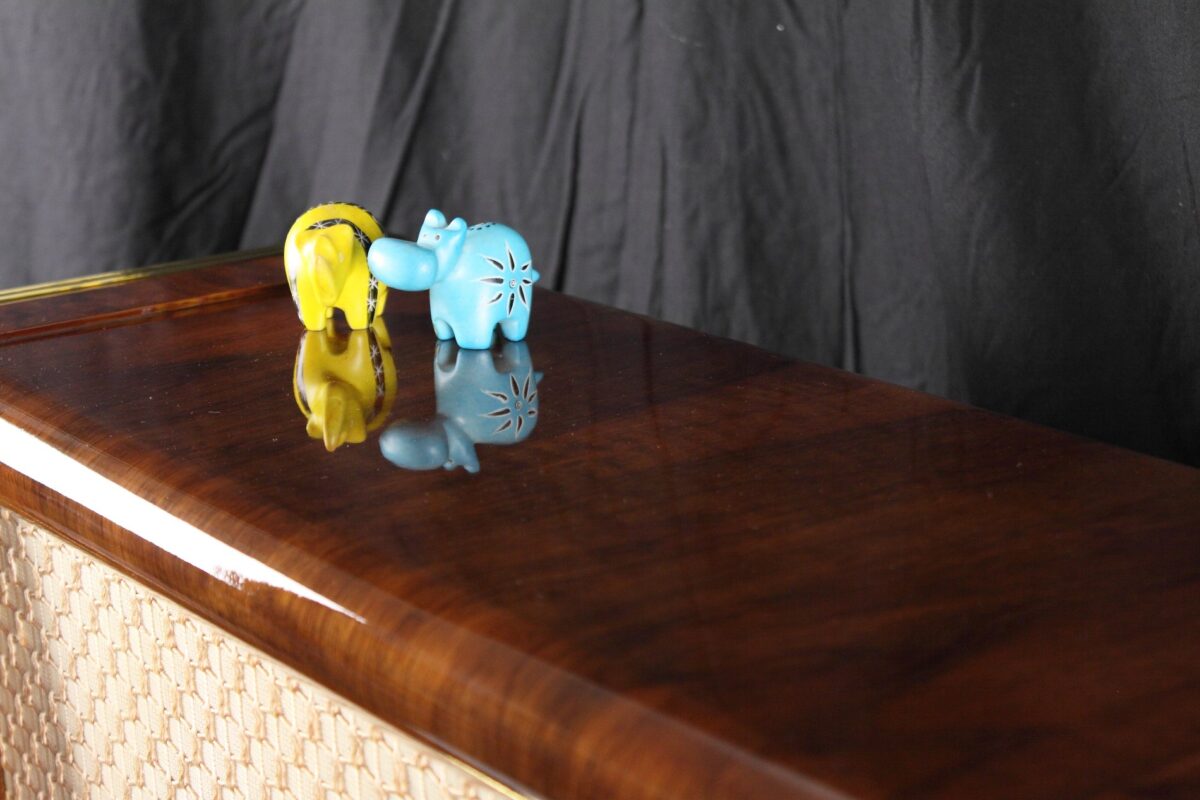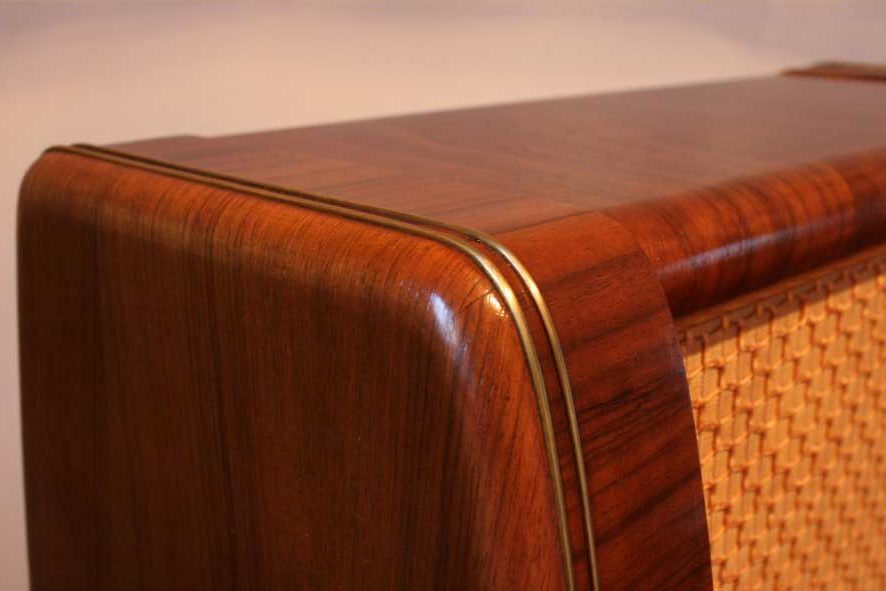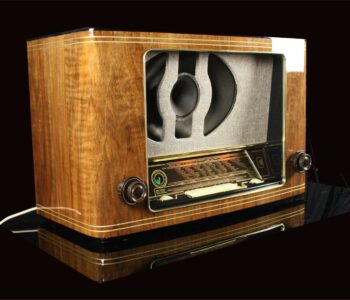 german radios - en
german radios - en
Graetz Spitzen Super 177W – en
- by giovanni
Graetz Spitzen Super 177W
GRAETZ SPITZEN SUPER 177W
The Graetz Spitzen Super 177W is the most prestigious Graetz radio produced in the early 50s. “Spitzen Super” means extra strong, the device’s vocation.
This device is huge and does not hide its pride of being on the A list. The cabinet, in my opinion, is the best among the Graetz devices. The wood flames are deliberately noticeable and give the cabinet a certain lightness. Its blunted edges and again lighten the overall aspect of the cabinet.
The sound of this device is rather smooth and its knobs can be turned without twitches. Tuning stability is given by the heavy fly-wheel located on the same axis of the control and ensuring inertia.
The power stage is a push-pull of two EL84 like many other later Hi-Fi amplifiers. The remarkable loudspeaker array with a huge wide band elliptical woofer, an elliptical midrange and a cone tweeter on the backside.
The sound is powerful and very precise. Graetz favored sound quality over pure power and wanted to document the details of this choice. Further on, on this page, you can find an entire section describing the actions made on this device. Usual profound bass, medium is there and acute is sharp. Clearly the valve final creates no problem with the listening.
This Graetz is certainly the result of an accurate study and of an expensive project in order to be among the best at that time.
The counterreaction circuits are very complex and tone controls are inside them, so that the emphasis given to the controls varies according to the volume. This effects adds to the fact that the circuit is equipped with a more than one stage loudness. When the acute sounds are at the highest the medium AM bell-shaped curve can be changes with the help of a switch integrated in the potentiometer. By doing this the acute sounds of that band can be further raised.
Many other remarkable elements characterize this device. An example is the number of condensers employed. A beautiful high quality device, with a fascinating aesthetics, perfectly functioning and with a powerful and “cozy” sound.
-
BLUETOOTH
Bluetooth receiver embed -
MULTI PLATFORM CONNECTION
Each radio is equipped with a cable for connection to any digital device.
TUBESOUND IMPROVEMENT
- Bluetooth receiver embed - The unit is equipped with a BLUETOOTH receiver powered directly by the receiver power supply. This makes it possible to control the amplifier from any external digital device as an IPAD, a Smartphone, or a sophisticated multimedia station. So you can hear your preferred web station or your lossesless file without cables on the room. Wireless Receiver can be equipped upon requests.
- Multi Platform Connection - A customized adaptation cable to connect any digital device as Iphone, Smartphone, Laptop, CD Player etc. will be provided with this radio. This special cable suits the different impedances between the modern equipment and the receiver. Furthermore the two stereo channels flow into one without increasing the load to the input unit.

Graetz factory
HISTORY
The Ehrich & Graetz metalworks was a factory established in 1866 in Berlin by Albert Graetz (1831–1901) and the tradesman Emil Ehrich (died 1887) under the name "Lampen-Fabrik Ehrich & Graetz OHG" (E&G).
By 1897 the firm was controlled by Albert's sons, Max Graetz, and Adolf Graetz. The company grew rapidly, and in 1899 factory complexes were built in Berlin, in the United States, France, the UK, and Bombay.
Around 1910-1916 Max Graetz developed the famous Petromax Lantern. Around 1925 the factory also produced radios, and other electrical appliances under the name Graetzor.
In the Second World War, just as in the First World War, the company was part of the war industry. With the use of forced laborers from France, Russia and the Netherlands the company made huge gains in production.
At the end of April 1945 the factory was claimed by the Russian army.
In 1949 the firm became part of the "peoples" program, "VEB-VolksEigenerBetrieb" and since 1950 "VEB Fernmeldewerk, Berlin Treptow (RFFT)." VolksEigenerBetrieb, means that the factory was owned by the people for the people (Communism)
In 1948 Erich, and Fritz Graetz founded a new company in Altena, Germany known by the name The Graetz Firm, which was successor to the lost family company in Berlin. The new company produced mainly radios and televisions.
In 1961 the company was then sold to Standard Elektrik Lorenz (SEL) AG, but since 1987 has been to the present owned by the Finnish company Nokia.
MAIN FEATURES
Year of production: 1954/55
Superheterodyne IF 468/10700
7 AM Circuits
12 FM Circuits
Wavebands:
Medium Waves(OM1, OM2), Long Waves (OL)
Short waves (OC), FM (UKW)
1 Elliptical mid-woofer
1 Elliptical midrange
1 Tweeter
Dimensions (LHD): 26.9 x 16.5 x 12.8 inch
Net weight: 39 lb 11 oz
10 Tubes:
3 x EC92, 2 x EF41, ECH81, EM34, EABC80, 2 x EL84

TONE CONTROL WITH LEVEL INDICATION
The tones control system is very efficient. Above the large tone control knobs there is a band that lights up gradually indicating the emphasis on the band on which it acts.
AERIALS
Inside the cabinet there is a dipole for FM reception and a ferrite rotating aerial for AM reception.
Ferrite aerial can be rotated from the outside to achieve a perfect tuning of the device in the AM.
In this picture see the rotation mechanism and the position indicator of the aerial.
The reception sensitivity with internal aerials is very good. This unit was in fact produced in a period when there were not many radio stations and those available fairly apart from each others.
Using an external aerial sensitivity is further increased.


SEPARATE CONTROL TUNING BETWEEN AM AND FM
The tuning system is another gem.
The unit is equipped with mechanisms for keeping separate the AM and FM bands.
The tuning knob is single but a selector switch commutes into cable systems (all in steel) and pulleys separated depending on the band.
The movement is transferred to both mechanisms with a system of pulleys and separated gears.
TUNING INDICATOR
The magic eye has of course been replaced.


LOUDSPEAKERS
The front speaker set.
Note the big mid/woofer compared with the lens cap of my SLR camera.
CONTROL PANEL

On the left side you can see the volume control knob (with incorporated loudness).
On the same axis there is the regulation of the ferrite aerial.
On the right the magic eye indicating the perfect tuning of each station.
Below the bass tones indicator and further below its control knob.
The Long, Medium, and Short Wave AM scale and the FM scale.
On left-hand corner on the bottom the Off, record player, recorder buttons and those for Long, Medium 1, 2, Short and FM Wave bands.
On the right the treble indicator and its control knob.

REAR SIDE
Output for external speakers.
Socket for recorder (tonbandgerat).
Turntable input (Tonabnehmer)
AM and FM aerial inputs and ground socket.
INSTRUMENTAL ANALYSIS
For the first time and only for this machine, I decide to post the instrumental collection of data
regarding the frequency response of the low frequency stage. it is a simple and incomplete waves
collection of data yet enough precise and indicating the quality of amplifiers of that time.
Measures on the final stage have been conducted with an inductive load, therefore the square wave
is affected by form distortion.
 Preamplifier - Sine Wave - 1000 Hz
Preamplifier - Sine Wave - 1000 Hz Preamplifier - Triangle Wave - 1000 Hz
Preamplifier - Triangle Wave - 1000 Hz Preamplifier - Square Wave - 1000 Hz
Preamplifier - Square Wave - 1000 Hz Inverter stage - Triangle Wave - 1000 Hz
Inverter stage - Triangle Wave - 1000 Hz Anode output power tubes - Sine wave - 1000 Hz
Anode output power tubes - Sine wave - 1000 Hz Output on own loudspeakers - Square wave - 1000 Hz
Output on own loudspeakers - Square wave - 1000 Hz Output on own loudspeakers - Sine wave - 20 Hz
Output on own loudspeakers - Sine wave - 20 Hz Output on own loudspeakers - Sine wave - 100 Hz
Output on own loudspeakers - Sine wave - 100 Hz Output on own loudspeakers - Sine wave - 5000 Hz
Output on own loudspeakers - Sine wave - 5000 Hz Output on own loudspeakers - Sine wave - 15000 Hz
Output on own loudspeakers - Sine wave - 15000 Hz
RESTORING WORKS
THE USUAL AMAZING LAST IMAGE
















































